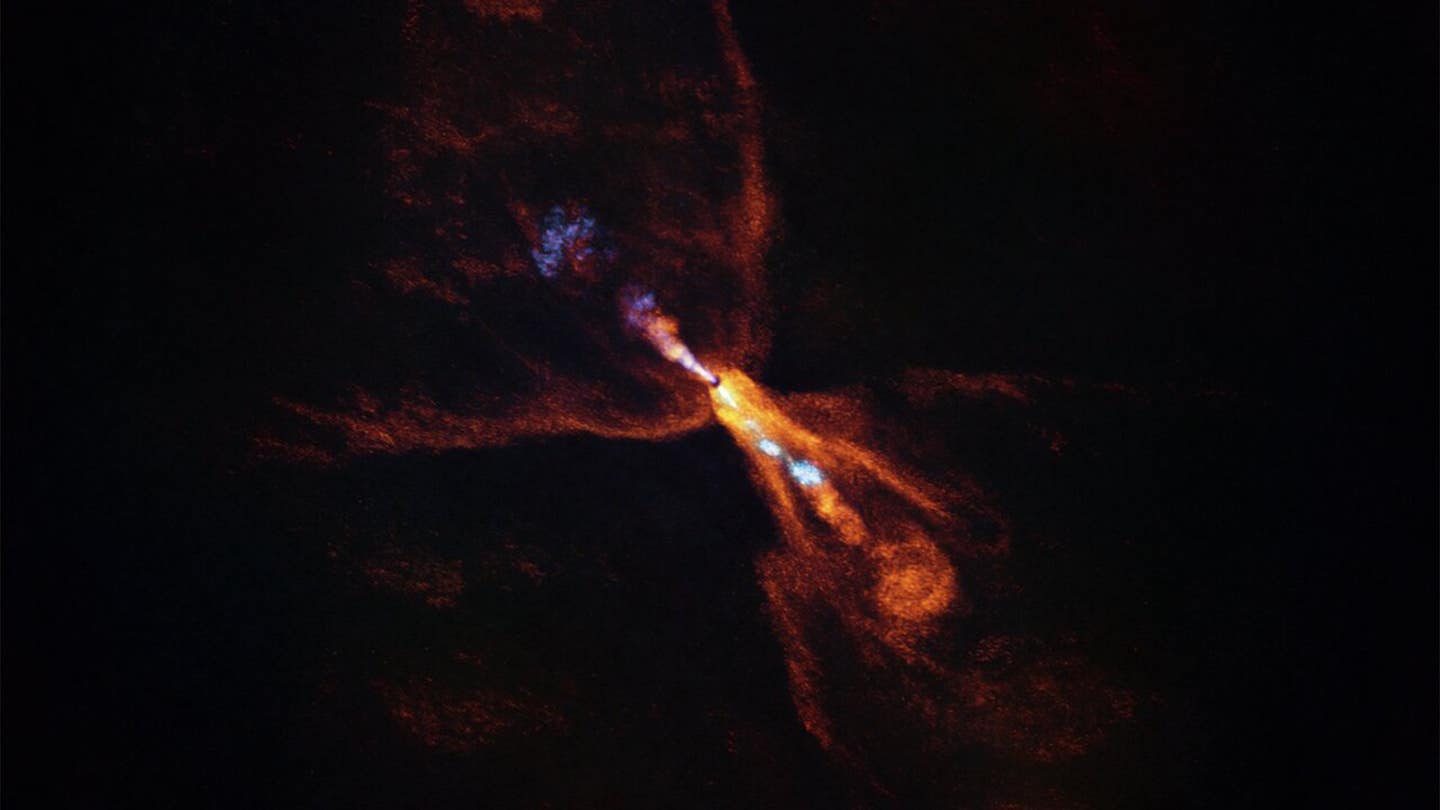Historical first: Scientists observe the birth of a solar system 1,300 light-years away
Astronomers observe the birth of planets around a young star, offering clues to how our solar system began 4.6 billion years ago.

Scientists have observed the earliest signs of planet formation. ALMA image of HOPS-315, a baby star that is still forming. (CREDIT: ALMA (ESO/NAOJ/NRAO)/M. McClure et al.)
Deep in space, astronomers have witnessed a rare and powerful moment: the birth of planets around a distant baby star. This discovery, made with the help of two of the world’s most advanced telescopes, offers a direct glimpse into how planetary systems—like our own—begin to take shape.
The discovery centers around HOPS-315, a young protostar located about 1,300 light-years away in the Orion B molecular cloud. While researchers have long studied stars surrounded by planet-forming disks, this new finding captures the very start of that transformation.
For the first time, scientists have caught solid particles—essential to forming planets—just beginning to condense from hot gas. It’s like spotting the first sparks that will someday forge entire worlds.
A snapshot of the solar system’s distant past
This discovery was made possible by the James Webb Space Telescope (JWST) and the Atacama Large Millimeter/submillimeter Array (ALMA) in Chile. These tools allowed astronomers to detect hot minerals solidifying within HOPS-315’s surrounding disk. What they found closely mirrors early events believed to have happened in our own solar system over 4.5 billion years ago.
Melissa McClure, an astronomer at Leiden University and lead author of the study, described it as the “earliest moment when planet formation is initiated around a star other than our Sun.” Her colleague, Purdue University astronomer Merel van ‘t Hoff, added, “We’re seeing a system that looks like what our solar system looked like when it was just beginning to form.”
These results give researchers a model for how Earth and its neighboring planets could have started. By observing how matter first cools and clumps around a star like HOPS-315, scientists get a clear window into the past—one locked inside ancient meteorites and cosmic dust.
Related Stories
- Why are giant planets found at the outer reaches of solar systems
- Scientists detect signs of a hidden planet in our solar system
- From gas giants to rocky worlds: Why planets in our solar system differ
The seeds of planets begin to form
At the center of this finding is the detection of silicon monoxide, a chemical that appears in both gas form and in crystalline minerals. These minerals were spotted condensing within a disk located about 2.2 astronomical units from the star—the same range as the asteroid belt in our own solar system.
“This process has never been seen before in a protoplanetary disk—or anywhere outside our solar system,” said Edwin Bergin, an astrophysicist at the University of Michigan. The team detected forsterite and enstatite—types of magnesium-rich silicates—that form only at very high temperatures. This aligns with how early solid materials formed in our solar system before gathering into mile-wide planetesimals.
Meteorites that have landed on Earth preserve many of the same minerals, which were created during the Sun’s infancy. Scientists believe these rocky bits eventually came together to build the planets and moons we see today. By identifying similar materials in the disk around HOPS-315, astronomers now have living evidence of that first stage.
A cosmic thermostat builds worlds
The formation of these early solids requires intense heat—around 1,300 degrees Kelvin. At these temperatures, rocky grains vaporize and then recondense, forming crystalline minerals in a delicate balance. Researchers refer to this area as a “thermostat region,” where temperature and pressure allow for specific elements to turn into solids that will later become planets.
The JWST’s spectrometers picked up detailed absorption signals showing the presence of these minerals, while ALMA helped locate exactly where in the disk they formed. The data showed that the absorbing layer of minerals sits just beneath a warmer surface that emits hydrogen. This layering matches models of how materials arrange themselves in disks around stars with strong accretion, where material is still feeding the growing star.
ALMA’s high-resolution imaging confirmed that these minerals weren’t coming from a dusty jet or outflow. Instead, they originated directly from a disk region where planet seeds are born. That’s a big step forward for understanding how solid matter survives and evolves in these early stages.
A star with a familiar path
HOPS-315 is an orange dwarf star, still in the process of forming. It has about 60 percent the mass of the Sun but continues to gain more through streams of gas. In about a million years, it may reach a size similar to our star. Because of these similarities, researchers believe HOPS-315 offers one of the best opportunities to study what our solar system looked like when it was just a cosmic nursery.
“This system is one of the best that we know to actually probe some of the processes that happened in our solar system,” said van ‘t Hoff. Elizabeth Humphreys of the European Southern Observatory, who was not part of the study, praised the work, saying it “highlights the combined strength of JWST and ALMA for exploring protoplanetary disks.”
Researchers also noted how the disk’s chemistry shows signs of interstellar dust being reset—meaning old material is transformed into gas, then into new minerals. That transformation plays a crucial role in setting the stage for planets to form.
Reading the universe’s memory
By using the spectra collected through JWST’s infrared cameras, the team confirmed the presence of strong absorption bands from various minerals. These included forsterite and enstatite, as well as a tentative detection of silica. At the same time, gas-phase molecules such as water, carbon monoxide, and silicon monoxide were also measured, allowing researchers to determine their temperature and motion.
The SiO gas was found to be moving at about –10.6 km/s, which is too slow to be part of the high-speed jet coming from the star. This confirmed that the gas, and the solids forming from it, are part of a calmer inner disk region—right where planet seeds should be forming.
These layers appear stacked like an atmosphere, with cooler minerals sitting below hotter hydrogen gas. This structure has been predicted in models but had never been confirmed until now.
Building blocks across the galaxy
This moment marks the “t = 0” point—the start of solid matter forming around a new star. While only a single star system has shown this exact pattern so far, it opens the door for many more discoveries. The more stars astronomers observe with this level of detail, the more they can understand the patterns and pathways of planetary evolution.
With ever more powerful telescopes coming online, astronomers are now better equipped than ever to find more newborn planetary systems. HOPS-315 is likely the first of many stars that will help unlock the universal rules of planet formation.
The data doesn’t just tell us how things form. It tells us when, where, and under what conditions life’s building blocks begin their journey.
Research findings are available online in the journal Nature.
Note: The article above provided above by The Brighter Side of News.
Like these kind of feel good stories? Get The Brighter Side of News' newsletter.



